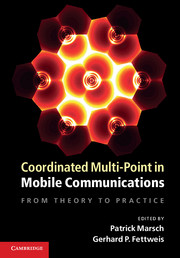Book contents
- Frontmatter
- Contents
- List of Contributors
- Acknowledgements
- List of Abbreviations
- Nomenclature and Notation
- Part I Motivation and Basics
- Part II Practical CoMP Schemes
- Part III Challenges Connected to CoMP
- Part IV Performance Assessment
- Part V Outlook and Conclusions
- 15 Outlook
- 16 Summary and Conclusions
- References
- Index
16 - Summary and Conclusions
from Part V - Outlook and Conclusions
Published online by Cambridge University Press: 05 August 2012
- Frontmatter
- Contents
- List of Contributors
- Acknowledgements
- List of Abbreviations
- Nomenclature and Notation
- Part I Motivation and Basics
- Part II Practical CoMP Schemes
- Part III Challenges Connected to CoMP
- Part IV Performance Assessment
- Part V Outlook and Conclusions
- 15 Outlook
- 16 Summary and Conclusions
- References
- Index
Summary
Summary of this Book
In this book, coordinated multi-point (CoMP) has been investigated from the point of view of a multitude of authors, some of which have been working in this field since a decade. Clearly, the different opinions stated throughout the book emphasize that CoMP is still a controversially discussed topic, and it is still too early to draw final conclusions. Nevertheless, we now want to briefly review the contributions in this book and try to extract a more or less conclusive big picture.
Most Promising CoMP Schemes and Potential Gains
First, let us summarize the key CoMP schemes discussed in this book, which were categorized according to the extent of base station (BS) cooperation involved:
Non-cooperative, but interference aware transceiver techniques have been investigated in Section 5.1. Here, LTE Release 8 style precoding is used in the downlink, in conjunction with multi-cell interference estimation at the receiver side, which was also covered in Section 10.2. The results predict large gains from using smart multi-cell pilot and channel estimation schemes, even though no cooperation between BSs is required.
Interference coordination schemes, in comparison, are based on some limited extent of information exchange between BSs. In Section 5.2, multi-cell interference prediction through the exchange of scheduling tables and coordinated scheduling by a central unit were introduced, yielding average spectral efficiency gains of more than 20%, according to system level simulation results in Section 14.3.
- Type
- Chapter
- Information
- Coordinated Multi-Point in Mobile CommunicationsFrom Theory to Practice, pp. 455 - 460Publisher: Cambridge University PressPrint publication year: 2011



